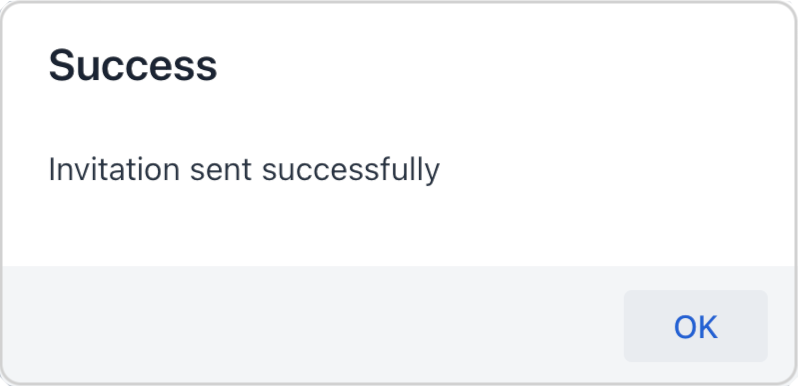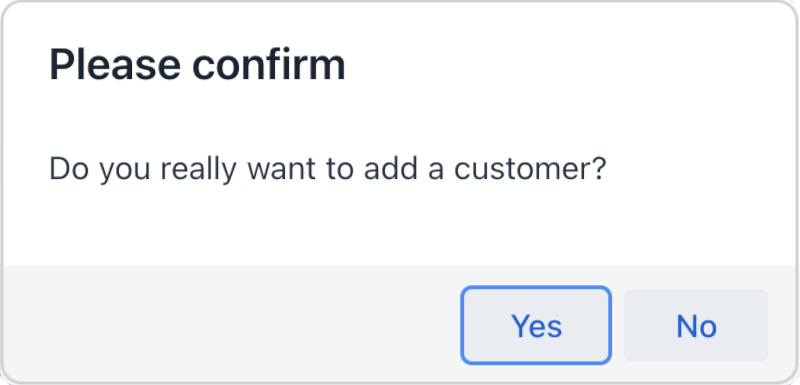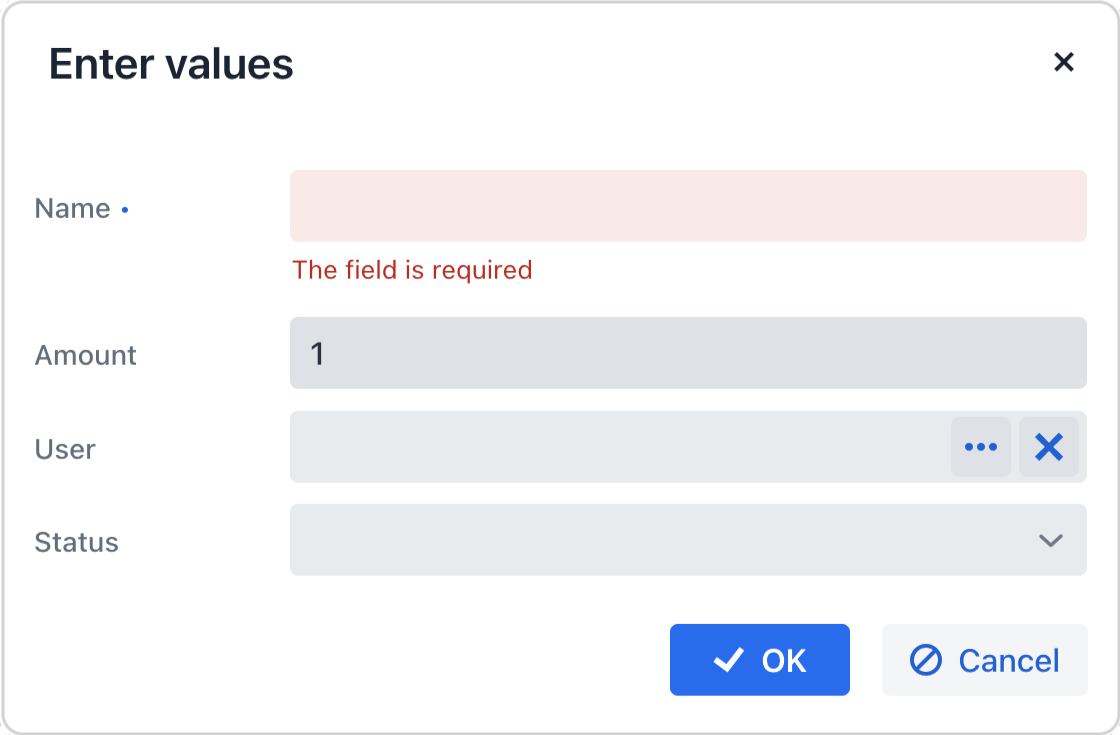对话框
Dialogs 接口用来展示标准的对话框窗口。对话框窗口是一个小的弹出窗口,可以在当前页面叠加展示信息或者 UI 元素。
使用流式接口可以创建和展示对话框,入口方法是 createMessageDialog()、createOptionDialog() 和 createInputDialog()。
消息对话框
使用消息对话框的最基本场景就是为用户展示某些消息。

下面示例中,当用户点击一个按钮时,展示一个消息对话框:
@Autowired
private Dialogs dialogs;
@Subscribe("messageDialogButton")
public void onHelloButtonClick(ClickEvent<Button> event) {
dialogs.createMessageDialog()
.withHeader("Success") (1)
.withText("Invitation sent successfully") (2)
.open();
}| 1 | 添加对话框标题。 |
| 2 | 添加消息内容。 |
文本格式化
文本的格式化可以通过 HTML 实现。对话框可以通过 withContent() 方法展示 HTML 内容。给定的 HTML 会封装在组件中:
@Autowired
private Dialogs dialogs;
Html htmlContent = new Html("<p>Here starts a paragraph. A new line starts after this.<br />" +
"<b>This text is bold.</b> <i>This text is italic.</i></p>");
@Subscribe("htmlContentButton")
public void onHtmlContentButtonClick(ClickEvent<Button> event) {
dialogs.createMessageDialog()
.withHeader("HTML Formatting")
.withContent(htmlContent)
.open();
}显示设置
使用下列方法可以对消息对话框的外观显示和行为进行设置:
-
withModal()- 如果该方法设置false,则对话框不以模态框方式展示,也就是说,用户还可以与应用的其他部分进行交互。对话框默认为模态框展示。
-
withCloseOnOutsideClick()- 当设置为true时,如果对话框是模态展示,则支持用户通过点击对话框外的区域进行关闭。
-
withWidth()、withHeight()- 设置对话框的大小。
示例:
@Autowired
private Dialogs dialogs;
@Subscribe("customDialogButton")
public void onSanitizeButtonClick(ClickEvent<Button> event) {
dialogs.createMessageDialog()
.withHeader("Information")
.withText("This is a custom dialog")
.withCloseOnOutsideClick(true)
.withWidth("600px")
.withHeight("200px")
.open();
}选项对话框
选项对话框能展示消息和一组用户交互的按钮。

使用 withActions() 方法提供 操作,每个操作都由对话框中的一个按钮展示。示例:
@Autowired
private Dialogs dialogs;
@Subscribe("selectOptionButton")
public void onSelectOptionButtonClick(ClickEvent<Button> event) {
dialogs.createOptionDialog()
.withHeader("Please confirm")
.withText("Do you really want to add a customer?")
.withActions(
new DialogAction(DialogAction.Type.YES)
.withHandler(e -> addCustomer()), (1)
new DialogAction(DialogAction.Type.NO)
)
.open();
}| 1 | 如果点击 Yes,则对话框关闭并调用 addCustomer() 操作方法。 |
用 DialogAction 基类可以创建标准操作。支持 5 种通过 DialogAction.Type 枚举类型定义的操作:OK、CANCEL、YES、NO、CLOSE。按钮的名称从主消息包获取。
输入对话框
输入对话框是一个多功能的工具,可以使用 API 构建输入表单,摆脱为琐碎的数据输入创建界面的麻烦。支持不同类型数据的输入、验证输入数据以及为用户提供不同的操作。

下面我们看几个例子。
标准参数
使用 withParameters() 方法添加参数,每个参数都会在对话框中显示为一个输入框。
下面的示例中,输入对话框带有标准类型的参数和标准的 OK/Cancel 操作:
@Autowired
private Dialogs dialogs;
@Subscribe("standardParametersButton")
public void onStandardParametersButtonClick(ClickEvent<Button> event) {
dialogs.createInputDialog(this)
.withHeader("Enter values")
.withParameters(
stringParameter("name").withLabel("Name").withRequired(true), (1)
intParameter("amount").withLabel("Amount").withDefaultValue(1), (2)
entityParameter("user", User.class).withLabel("User"), (3)
enumParameter("status", OnboardingStatus.class).withLabel("Status") (4)
)
.withActions(DialogActions.OK_CANCEL) (5)
.withCloseListener(closeEvent -> {
if (closeEvent.closedWith(DialogOutcome.OK)) { (6)
String name = closeEvent.getValue("name"); (7)
int amount = closeEvent.getValue("amount");
User user = closeEvent.getValue("user");
OnboardingStatus status = closeEvent.getValue("status");
// process entered values...
}
})
.open();
}| 1 | 指定一个必填的字符串参数。 |
| 2 | 指定一个带有默认值的整型参数。 |
| 3 | 指定一个实体参数。 |
| 4 | 指定一个枚举参数。 |
| 5 | 指定标准的 OK/Cancel 操作,放置于对话框底部。 |
| 6 | 在关闭事件监听器中,我们可以检查用户使用了什么操作。 |
| 7 | 关闭事件包含了输入的值,可以通过参数标识符进行获取。 |
自定义参数
下面的示例展示了创建自定义参数并支持用户通过 combobox 进行选择:
@Autowired
private Dialogs dialogs;
@Autowired
private DataManager dataManager;
@Autowired
private UiComponents uiComponents;
@Subscribe("customParameterButton")
public void onCustomParameterButtonClick(ClickEvent<Button> event) {
dialogs.createInputDialog(this)
.withHeader("Enter values")
.withParameters(
stringParameter("name").withLabel("Name").withRequired(true),
intParameter("amount").withLabel("Amount").withDefaultValue(1),
parameter("user") (1)
.withLabel("User")
.withField(() -> {
EntityComboBox<User> field = uiComponents.create(EntityComboBox.class); (2)
field.setItems(dataManager.load(User.class).all().list()); (3)
field.setWidthFull();
return field;
}),
enumParameter("status", OnboardingStatus.class).withLabel("Status")
)
.withActions(DialogActions.OK_CANCEL).withCloseListener(closeEvent -> {
if (closeEvent.closedWith(DialogOutcome.OK)) {
String name = closeEvent.getValue("name");
int amount = closeEvent.getValue("amount");
User user = closeEvent.getValue("user");
OnboardingStatus status = closeEvent.getValue("status");
// process entered values...
}
})
.open();
}| 1 | 指定一个自定义参数。 |
| 2 | 为自定义参数创建 combobox。 |
| 3 | 为 combobox 加载选项。 |
自定义校验
对话框默认带有一些基础的校验:验证输入值的类型、检查必填项是否为空。在这之上,可以添加其他通用的自定义校验。
下面的示例添加了一个校验,要求至少输入一个参数:
@Autowired
private Dialogs dialogs;
@Subscribe("validationButton")
public void onValidationButtonClick(ClickEvent<Button> event) {
dialogs.createInputDialog(this)
.withHeader("Enter at least one value")
.withParameters(
stringParameter("name").withLabel("Name").withRequired(true),
entityParameter("User", User.class).withLabel("User")
)
.withValidator(context -> { (1)
String name = context.getValue("name"); (2)
User user = context.getValue("user");
if (Strings.isNullOrEmpty(name) && user == null) {
return ValidationErrors.of("Enter name or select a customer"); (3)
}
return ValidationErrors.none();
})
.withActions(DialogActions.OK_CANCEL)
.withCloseListener(closeEvent -> {
if (closeEvent.closedWith(DialogOutcome.OK)) {
String name = closeEvent.getValue("name");
User user = closeEvent.getValue("user");
// process entered values...
}
})
.open();
}| 1 | 自定义验证逻辑,保证至少有一个参数。 |
| 2 | 验证器内,参数可以从 context 对象获取。 |
| 3 | 如果没有输入任何参数,则抛出验证错误。 |
